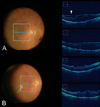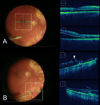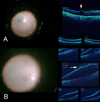Clinical utility of intraoperative optical coherence tomography
- PMID: 26918786
- PMCID: PMC4936526
- DOI: 10.1097/ICU.0000000000000258
Clinical utility of intraoperative optical coherence tomography
Abstract
Purpose of review: To explore the clinical utility of intraoperative optical coherence tomography (iOCT) for the management of vitreoretinal conditions.
Recent findings: The role of iOCT in guiding surgical decision-making and surgical manipulations during vitreoretinal procedures has been evaluated by multiple studies. This imaging modality is emerging as a valuable asset during procedures for vitreoretinal interface disorders, retinal detachments, submacular surgeries and therapeutics, and in pediatric conditions such as retinopathy of prematurity. iOCT allows the surgeon to assess completion of surgical goals and to directly monitor the architectural impact of instrument-tissue interactions that may correlate with eventual prognosis. The technology has gone through numerous iterations with the eventual goal being the development of a user-friendly, efficient, and integrated system that provides surgeons with 'real-time' feedback during ophthalmic surgeries to allow for a comprehensive image-assisted vitreoretinal surgery platform.
Summary: The role of iOCT in ophthalmic surgery has been evolving with the help of ongoing research to define its utility in the operating room and to develop integrative technologies. Advancements in OCT-friendly surgical instrumentation and in integrative capabilities of this technology may help achieve more widespread adoption of this technology in the vitreoretinal surgical theater. Although the evidence appears clear that this technology impacts surgical decision-making, additional research is needed. However, further research is needed to determine the influence of this technology on overall patient outcomes.
Figures





References
-
- Hee MR, Izatt JA, Swanson EA, Huang D, Schuman JS, Lin CP, Puliafito CA, Fujimoto JG. Optical coherence tomography of the human retina. Archives of ophthalmology. 1995;113(3):325–332. - PubMed
-
- Swanson EA, Izatt JA, Hee MR, Huang D, Lin CP, Schuman JS, Puliafito CA, Fujimoto JG. In vivo retinal imaging by optical coherence tomography. Optics letters. 1993;18(21):1864–1866. - PubMed
-
- Chen TC, Cense B, Pierce MC, Nassif N, Park BH, Yun SH, White BR, Bouma BE, Tearney GJ, de Boer JF. Spectral domain optical coherence tomography: Ultra-high speed, ultra-high resolution ophthalmic imaging. Archives of ophthalmology. 2005;123(12):1715–1720. - PubMed
-
- Brown DM, Kaiser PK, Michels M, Soubrane G, Heier JS, Kim RY, Sy JP, Schneider S. Ranibizumab versus verteporfin for neovascular age-related macular degeneration. The New England journal of medicine. 2006;355(14):1432–1444. - PubMed
-
- Heier JS, Brown DM, Chong V, Korobelnik JF, Kaiser PK, Nguyen QD, Kirchhof B, Ho A, Ogura Y, Yancopoulos GD, Stahl N, et al. Intravitreal aflibercept (vegf trap-eye) in wet age-related macular degeneration. Ophthalmology. 2012;119(12):2537–2548. - PubMed
Publication types
MeSH terms
Grants and funding
LinkOut - more resources
Full Text Sources
Other Literature Sources
Medical
Research Materials

